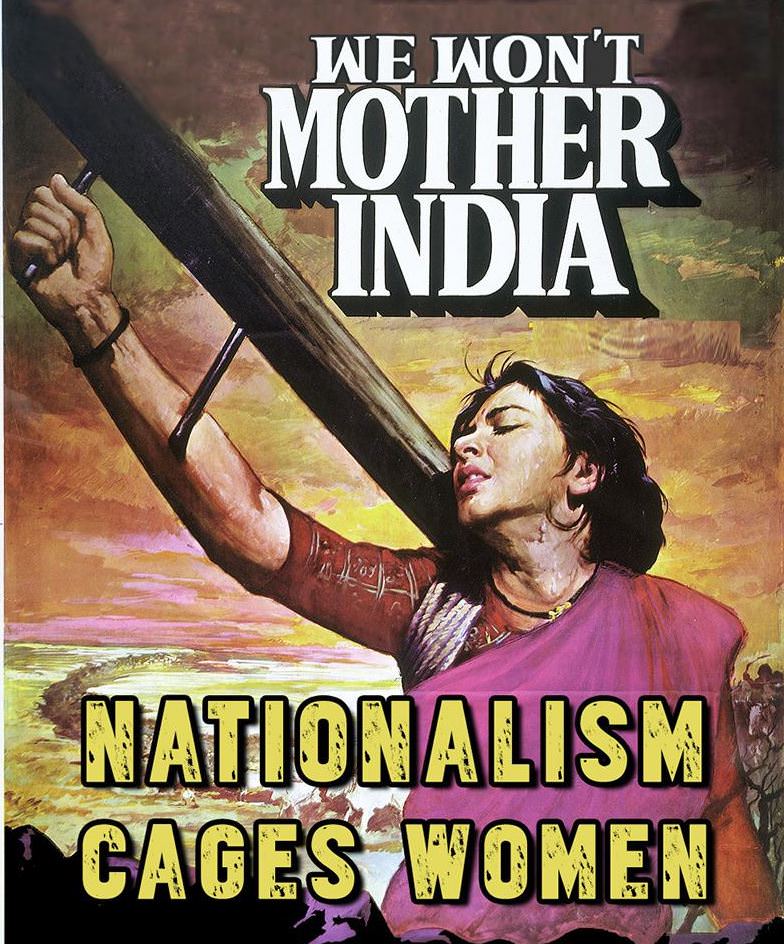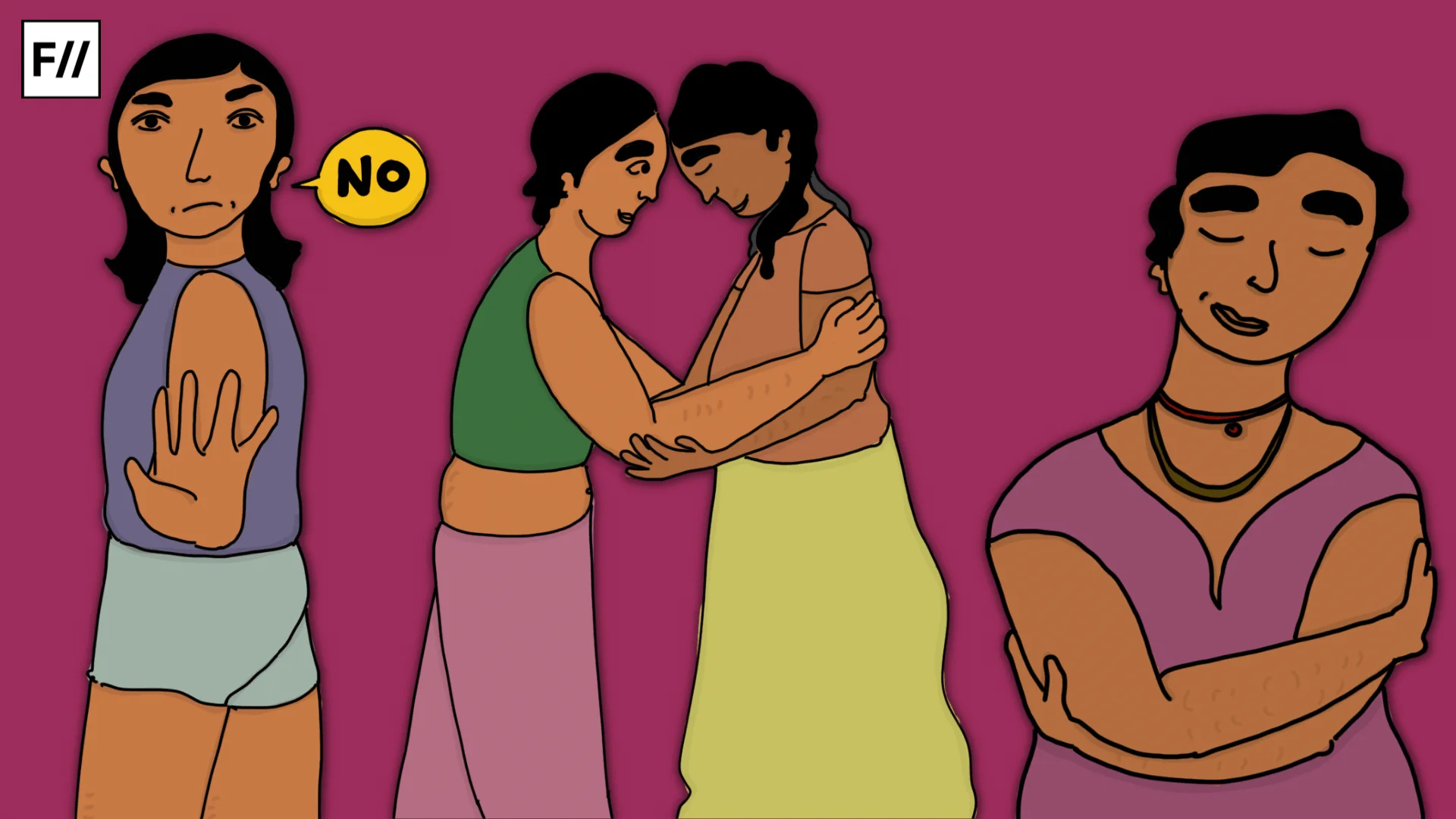Indian nationalist discourse has always referred to the Indian state as a specific kind of feminine entity: the ‘mother’. The chantings of “Bharat Maata” in a fit of nationalistic fervour is not a recent phenomenon, although it has become quite frequent of late. India was likened to a woman in a mother’s role even before it achieved its independence. In fact, the anthropomorphism of India into “Maata” is closely linked to its struggle for independence.
In patriarchal imagination, the figure of mother symbolises the ever nurturing, unconditionally loving and prosperous nature of the nation state. We are born in and brought up by this symbolic mother which comprises of land, resources, institutions, law, citizens et cetera. However, there is a lot more that this title suggests and implicates. The idea of India as a mother figure is deeply connected to women’s sexuality. The fertility or ability to produce babies after babies of a mother gets translated to the prosperity (economic and cultural) of the nation. While as a figurative mother figure, the nation is a nurturing and self-sacrificing entity, it also becomes a site that needs to be revered, protected and served. The Indian (man) becomes the son whose foremost nationalist duty is to protect his mother and her honour. Because “What kind of a man are you if you can’t even protect your own mother?“
Also read: Bharat Maata and the Ideal Indian Woman
The idea of India as mother or ‘Bharat Maata’ has grown quite strong lately in the contemporary Indian political scene. It has also met with considerable resistance from feminists and women’s organizations like Pinjra Tod. This is because the concept of India as a mother entails that the honour of a nation resides in its women, or rather the bodies of its women.
The idea of India as a mother figure is deeply connected to women’s sexuality.
Furthermore, it is only a particular kind of female body where this honour can reside. This body has to be a “pure” one, which means, a body free from all sins, desires, especially sexual desires, and filled with selfless emotions of love and sacrifice. This body cannot be that of a wife because she has to get involved in repeated sexual acts until she produces children and proves her “womanhood.” This body cannot be that of a Dalit woman or a lower class working woman either. The only ideal body that qualifies for being a “Bharat Maata” is that of an upper caste and class Hindu mother; of a woman who has used her sexuality to give an heir to her husband’s family and not experience sexual pleasures. The sexuality of a woman gets both invoked and repressed, defined and regulated the moment “Bharat Maata” is chanted through the air.
Since nation=mother=woman, when a woman is ‘defiled’ the mother nation is defiled too. You protect the chest where your treasure lies, you protect the body where your honour resides. Protection requires constant surveillance, control (through physical and ideological means), and sometimes violence. It kind of justifies and encourages the societal sexist restrictions on women’s lives and control on their sexualities.
Women’s Sexuality in Religious Nationalism versus Modern Nationalism
The early nationalists and freedom fighters equated nation’s honour with that of a woman’s honour which is linked to her sexuality. To liberate the motherland was to protect a woman’s ‘purity’ that must not be defiled in the hands of the ‘other’ (colonial masters). The construction of women’s sexuality in the pre-independence nationalist discourse can be understood by looking at Gandhi’s writings where he talks about religiosity and ‘female virtues’ needed for nationalist struggle.
Gandhi was of the view that “Politics divorced from religion has absolutely no meaning” and the ‘Indian woman’ was the repository of all religiosity for him. Gandhi, in particular, among the male nationalists played a crucial role in ‘feminization’ of the nation. He, along with several other reformers, worked towards breaking the age-old barriers of pardah and bringing women out of their homes to participate in protests, social service and awareness campaigns. At the same time, he also made examples of their traditionally believed or rather expected qualities of forbearance, selfless service and self-sacrifice to construct a non-violent independence movement.
Since nation=mother=woman, when a woman is ‘defiled’ the mother nation is defiled too.
Gandhi saw women as central to the discourse on swaraj or freedom. He invoked and redefined certain female characters from Hindu mythology who embodied the virtues he thought were necessary to fight for the nationalist cause. His repeated appeals to embrace the ‘female’ virtues essentialized women’s sexuality in a way that it became synonymous with chastity, purity, self-sacrifice, patience, self-control, dedication and suffering.
Sita’s sexuality was idealised because it was controlled and reserved for her husband only; she managed to retain her chastity even in the enemy’s captivity. “By using examples of mythical women such as Sita, Draupadi, and Savitri, Gandhi evoked a notion of non-violent suffering with which he identified the Indian national movement. But he failed to see the paradoxical oppression of the religious symbols he was using: Sita and Savitri are controlled representations of female sexualities whose roles are predetermined through their associations with strong husbands.”
Also read: The Draupadis Of Today: Exploring Draupadi With A Feminist Lens
Gandhi recognised women’s right to exercise control over their sexuality within marriage, but he made their domesticity a matter of abstinence and non-cooperation. He believed that women could and should peacefully deny sex with their husbands after the birth of their children; if the woman refused to cooperate, her husband would be forced to give up his carnal desires. That same formula he applied on the nation for the nationalist cause.
Sita’s sexuality was idealised because it was controlled and reserved for her husband only.
Opposed to Gandhi’s religious/spiritual nationalism, Nehru envisioned a nation that would be built on the pillars of modernity, progress and science. He realised that achieving gender equality was crucial to the process of India’s modernization. To fulfill his modern nationalist aspirations, he passed many laws to give political and economic freedom to women including the 1955 Hindu Marriage Act and the 1956 Hindu Succession Act.
In post-colonial India, population control had come to represent modernity and progress. In 1971, the liberal Medical Termination of Pregnancy Act was passed and women gained the power to control their reproductive life. However, on a closer analysis, one finds that this act only gave more power and ability to men to control women’s sexuality and body by forcing them to abort as soon as they found through amniocentesis that the fetus was female. Female foeticide became common and countless women were made to abort again and again. This caused many women permanent health damage and also took away from them whatever little sexual autonomy they previously possessed.
As Rao has explained in her work, in nationalist discourses, women are represented as ‘passive symbols of different totalities.’ Within the discourse of religious or spiritual nationalism they become the symbol of ‘sacrifice’ and ‘sacredness’ (Savitri and Sita), and within the discourse of modern nationalism they become the symbol of progress (with the power to control their sexuality by having reproductive rights through sex-determination tests and abortion). These symbols are ‘passive’ because they require the woman to remain voiceless and have her sexuality interpreted/represented by others (men). Hence the kind of nationalism you adhere to determines how you will look at a woman’s body and sexuality.
The Inner/Outer Dichotomy
Radhakrishnan has argued that nationalism becomes “The overarching umbrella that subsumes other and different forms of subspaces” including gender which results in displacement of the women’s question to the periphery. The ‘purity’ of the woman in the form of her regulated/controlled sexuality represents the ‘inner’ spiritual self of the nation. Nationalism constructed the so-called private, domestic, feminine sphere as the ‘interior’ of the nation – an autonomous space where the cultural/spiritual essence of the nation existed and which had to be protected by all means from the external Western impurities.
This construction of the interior self of the nation as the ‘uncolonized home’ led to a celebration of ‘domesticity’ itself. Women were expected to completely stay within the four walls of the household to protect this inner self of the nation. This shows how all kinds of nationalisms are constructed on the bodies and sexualities of women.
All kinds of nationalisms are constructed on the bodies and sexualities of women.
Woman’s Desexualization for Political Participation
How do you participate in a national political activity when you yourself are a symbol and agent of nationalist politics? In order to participate in a nationalist political activity, women have to negotiate their sexuality and femininity to fit in the system. This does not necessarily require abandonment of femininity but indeed the desexualization of the female body. Women “Can play complementary roles which draw on their socially constructed gender roles based on ideas of hegemonic femininity, motherhood for example. This focus on ‘‘woman as mother’’ also circumvents any potential criticism of their perceived violation of societally prescribed gender roles as they enter nationalist politics.” Hence the reason women political leaders have to become everyone’s “Amma” before they can command respect and legitimacy while male leaders do not have to act or look like anyone’s father to achieve the same.
‘Bharat Maata ki Jai’ indicates that both nation and the mother (woman) are worthy of worship. The deification of women perpetuates the cycle of misogyny and patriarchy because it puts them on pedestals and denies them their humanity. It expects a certain kind of behaviour from women and any deviance from the norm renders them undeserving of respect and safety.
Thus the mother-nation analogy is deeply problematic and needs to be deconstructed.
References:
- Radhakrishnan, Raj. (1992). Nationalism, gender, and narrative. In Andrew Parker, Mary Russo, Doris Sommer,& Patricia Yeager (Eds.), Nationalisms and Sexualities (pp. 77–95). New York: Routledge.
- Rao, Shakuntala. (May 1999). Woman-As-Symbol: Intersections of Indian Nationalism, Gender, and Identity. Women’s Studies International Forum. 22(3). 317-328
- Chatterjee, Partha. (1990). The nationalist resolution to the women’s question. In Kumkum Sangari & Sudesh Vaid (Eds.), Recasting women: Essays in Indian colonial history (pp. 233–253). New Brunswick, NJ: Rutgers University Press.
- Roy, Parama (1998). Indian Traffic: Identities in Question in Colonial and Postcolonial India, Berkeley. University of California Press.
- Gandhi, Mohandas. (1955). The Satyagraha Ashram. In Charles Andrews (Ed.), Mahatma Gandhi’s ideas. (pp.122–128). London: Allen and Unwin.
- John, Mary. Nair, Janaki (ed.) 1998. A Question of Silence: The Sexual Economies of Modern India. Kali for Women. P 1-32.
- Roy, Kumkum (ed.) 1999. Women in Early Indian Societies: Readings in Early Indian History. Delhi: Manohar
- Chanana, Karuna (2000). Female Sexuality and Education of Hindu Girls. In Rege, Sharmila (Ed). India Sociology of Gender: The Challenge of Feminist Sociological Thought. Sage Publications India.
- Banerjee, Sikata. (2003) Gender and Nationalism: The masculinisation of Hinduism and Female Political Participation in India. Women’s Studies International Forum. 26 (2). 167-179.
Featured Image Credit: Pinjra Tod
About the author(s)
Hira is a part-time researcher-writer and full-time existentialist. She passionately consumes philosophy, literature and cinema. Her areas of interest include World Literature, Sexuality Studies, Women's Writing and Post-colonial Studies.





A well written and informative article but the sequential flow and the arrangement in the story is missing in some extent.
From ancient times, the land we live on was worshiped as Mother land. And for any person, the motherland deserved higher place than heavens and Mother of himself.
Your point to term nation as mother to control sexualise is illogical. It is for emotions, not for arousing or refraining from sexual desires.
Centuries ago, and even now if there are people on this planet who believes in sharing their body only with their partner, that should be appreciated . Either you haven’t read scriptures and Ramayana or couldn’t understand properly.
Talking about gender equality and trying to raise women’s living standards should be appreciated, but your article seems to focus only on women’s sexuality- that’s it.
In a society, both the husband and wife have some control over each other. Based on their mutual understanding, they may agree on sharing their physical body or not with others. You should focus on empowering the women to become equal.
Feminism is welcome, freedom,equality is welcome. You should not have written about Sita and Ram in this way .
You literally lack of the knowledge or you have ill will towards Indian Historical persons and Hindus. Take care in future about posting such notes.
The article is written by someone who doesn’t understand even the iota of Indian culture and traditions. The writter looks at Indian traditions from a western lens. Argument presented is writer’s individual view and NOT the TRUTH.